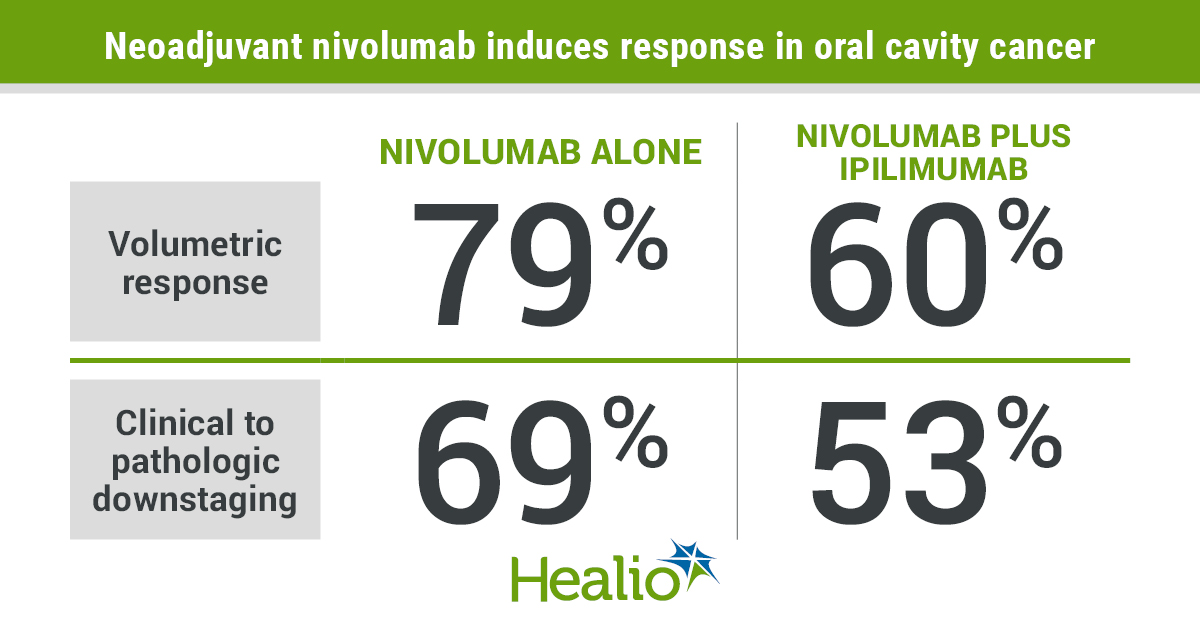Neoadjuvant nivolumab with or without ipilimumab induces response in oral cavity cancer
Neoadjuvant nivolumab with or without ipilimumab appeared effective and safe for patients with resectable oral cavity cancer, according to results of a randomized phase 2 study presented at Multidisciplinary Head and Neck Cancers Symposium.
“Both PD-1 inhibitors and CTLA-4 inhibitors act on immune checkpoint receptors on the surface of T cells, and they both work slightly differently,” Jonathan D. Schoenfeld, MD, MPH, senior physician at Dana-Farber/Brigham and Women’s Cancer Center and associate professor of radiation oncology at Harvard Medical Center, told Healio. “Several animal models showed this combination is more efficacious than either drug individually.”
Researchers believe the inhibitors target different aspects of immune response, Schoenfeld said.
“CTLA-4 works on generating an initial immune response, whereas PD-1 is more active in the tumor microenvironment inhibiting effective immune response,” he said. “Mechanistically, they complement each other.”

The analysis by Schoenfeld and colleagues included 29 patients with newly diagnosed squamous cell carcinoma of the oral cavity. The researchers randomly assigned patients to two cycles of the PD-1 inhibitor nivolumab (Opdivo, Bristol-Myers Squibb), dosed at 3 mg/kg, with or without a 1 mg/kg dose of the CTLA-4 inhibitor ipilimumab (Yervoy, Bristol-Myers Squibb) with the first cycle of treatment.
Most of the patients (n = 16) had oral tongue cancer, and all had stage T2 (n = 20) or higher (n = 9) tumors. Seventeen patients (58%) had node-positive disease.
Safety, tolerability and volumetric response — defined as any clinical, radiologic or pathologic decrease in bidirectional measurements — served as the study’s primary endpoints. Researchers set a prespecified goal of achieving a 15% response rate in either group.
Objective response per RECIST version 1.1 criteria, clinical-pathologic downstaging, pathologic response of primary tumor, DFS and OS served as secondary endpoints.
Patients underwent surgery 3 to 7 days after the second cycle of therapy. However, six patients did not receive the complete second-cycle dose because of an infusion reaction (n = 2), toxicity (n = 2), patient choice (n = 1) or concern about clinical progression (n = 1). One additional patient with T4 disease and evidence of radiologic tumor shrinkage switched to definitive chemoradiation.
“When you treat prior to surgery, the primary tumor is intact. Other studies have suggested that giving immunotherapy when the tumor is intact may induce a better response because the immune system can be educated better at the spot of that primary tumor,” Schoenfeld said. “If you give it early on, the hope is that the antitumor response by these drugs can continue over a long period of time, even after therapy is stopped.”
Results showed a 69% overall volumetric response rate, 61% clinical-pathologic downstaging rate, and 39% rate of moderate or better (> 50%) pathologic response.
Researchers observed volumetric response among 79% of patients who received nivolumab (n = 14) and 60% of patients who received nivolumab plus ipilimumab (n = 15), clinical to pathologic downstaging among 69% of the nivolumab group vs. 53% of the combination group, and moderate or better pathologic response among 23% with nivolumab vs. 53% with the combination.
Four patients achieved pathologic response greater than 90%, including one patient in the nivolumab group and three in the combination group.
After median follow-up 11 months, 90% of patients remained alive and disease-free.
“Oral cavity cancer is a notoriously difficult cancer with high rates of disease recurrence and death, and the side effects from standard treatment tend to be particularly challenging because the treated area is essential for speaking, swallowing and breathing,” Schoenfeld said in a press release. “We’re excited about moving immunotherapy earlier to treat more of these curative patients and, in the future, possibly reduce how aggressive their other treatments need to be.” – by John DeRosier
Reference:
Schoenfeld JD, et al. Abstract 1. Presented at: Multidisciplinary Head and Neck Cancers Symposium; Feb. 27-29, 2020; Scottsdale, Arizona.
Disclosures: Schoenfeld reports research funding and travel expenses from and/or consultant/advisory roles with AstraZeneca, Bristol-Myers Squibb, Debiopharm, Merck, Nanobiotix and Tilos. Please see the abstract for all other researchers’ relevant financial disclosures.

